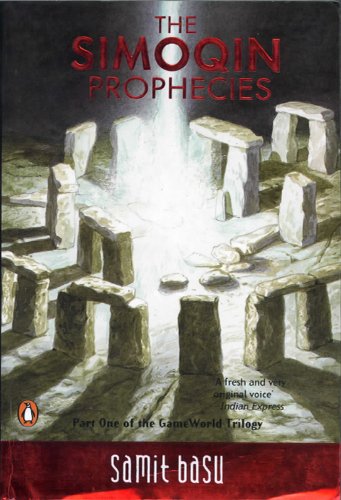What do you think?
Rate this book


512 pages, Kindle Edition
First published January 15, 2004
Triog’s ancestors were, like most ogres, from Ventelot. They were a very highly respected family of ogres, who had eaten many of the famous knights of the Almost-Perfectly-Circular Table, in the forgotten days when Ventelot was the mightiest kingdom in the whole world.
“Well, I had indeed agreed to lend Raka’s sword to Kol. But I’m afraid I cannot now.”
“And why not, may we ask?”
“Because,” said Rukmini, “Raka’s sword is lost.”
The standard replies to such dramatic revelations are ‘What!’, ‘How?’, or ‘Then die, infidel!’ but Gaam said, ‘Oh, there you are.’
“Low caste? The ravians had castes like they have in Avranti? But that’s horrible!”
Gaam looked at him sadly. “In your words, I see the work of Ventelot, and of Imokoi,” he said. I cannot understand the hatred the Avrantics and the Artaxerxians bear for each other. I have been to both countries. You have so much in common, your languages, your food, even your race… When other countries were wandering tribes, Avranti and Artaxerxia were discovering advanced mathematics together.”
“But some of the legends are false. So many dragons have died, out of old age, indigestion or sheer boredom, and knights have come to empty caves, stuck swords in the corpses, and posed for the portraits. And what of the heroes who are slain? No one sings about them. At most, there is the line in the epic that talks about the hundreds the monster has slain. That one of those hundreds might have removed a leg, a wing or even a head before dying is never mentioned.”
The Simoqin Prophecies, the first book in Samit Basu's GameWorld Trilogy, is a refreshing and wildly imaginative entry into the fantasy genre, blending humor, myth, and adventure in a way that both subverts and celebrates traditional fantasy tropes. Basu, with his sharp wit and vast knowledge of global mythologies, crafts a tale that is as much a homage to the genre as it is a critique, making it stand out in the crowded field of fantasy literature.
Plot Overview:
Set in a world where mythologies from various cultures collide, The Simoqin Prophecies tells the story of a prophecy that predicts the return of the powerful demon lord, Rakshas. The novel follows multiple characters, including Kirin, a young student at the Vaman Academy, Maya, a mysterious and powerful warrior, and Asvin, a prince with a destiny, as they navigate a world filled with gods, monsters, and political intrigue. The plot is filled with twists, humor, and references that will delight both seasoned fantasy readers and those new to the genre.
Character Development:
Basu’s characters are vibrant and multifaceted, each with their own quirks and complexities. Kirin is the reluctant hero, burdened with expectations and responsibilities he’s not sure he wants. Maya’s enigmatic nature and her journey of self-discovery add depth to the narrative. Asvin’s arc, which begins with the classic trope of a prince seeking glory, is subverted in surprising and entertaining ways. The supporting characters, including the comically villainous Danh-Gem and the resourceful Vanra, add layers of richness to the story.
Comparative Analysis:
When comparing The Simoqin Prophecies to its contemporaries, it’s clear that Basu’s work stands out for its unique blend of cultural references and satire. While Western fantasy series like J.K. Rowling’s Harry Potter or Terry Pratchett’s Discworld often draw from European mythology and folklore, Basu incorporates elements from Indian epics, Greek myths, and even popular culture, creating a truly global fantasy experience. The humor and satirical edge are reminiscent of Pratchett, but Basu’s narrative voice is distinctly his own, infusing the story with an Indian sensibility that sets it apart from the predominantly Western canon.
In terms of epic scope and world-building, Basu’s work can be compared to that of George R.R. Martin’s A Song of Ice and Fire or Brandon Sanderson’s Mistborn series. However, where Martin and Sanderson often delve into the darker, more serious aspects of their worlds, Basu opts for a lighter, more humorous tone, making his work accessible and enjoyable to a broader audience.
Critical Examination:
One critique of The Simoqin Prophecies is that the sheer number of cultural references and in-jokes might overwhelm readers who are not familiar with the source material. While this intertextuality is part of the novel’s charm, it can also be a barrier to those not well-versed in the mythologies and pop culture it draws upon. Additionally, the book’s playful tone and constant subversion of expectations might not appeal to readers who prefer a more straightforward, serious fantasy narrative.
Conclusion:
Overall, The Simoqin Prophecies is a standout debut that offers a fresh perspective on the fantasy genre. Samit Basu’s ability to blend humor, myth, and adventure into a cohesive and entertaining narrative is commendable. While it may not cater to everyone’s tastes, particularly those who prefer traditional epic fantasies, it is a must-read for those who appreciate a more irreverent and culturally diverse approach to the genre. Whether you’re a fan of Pratchett’s wit, Rowling’s magical world, or Sanderson’s intricate plots, The Simoqin Prophecies is likely to delight and surprise in equal measure.